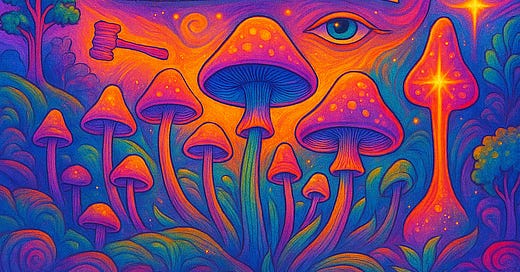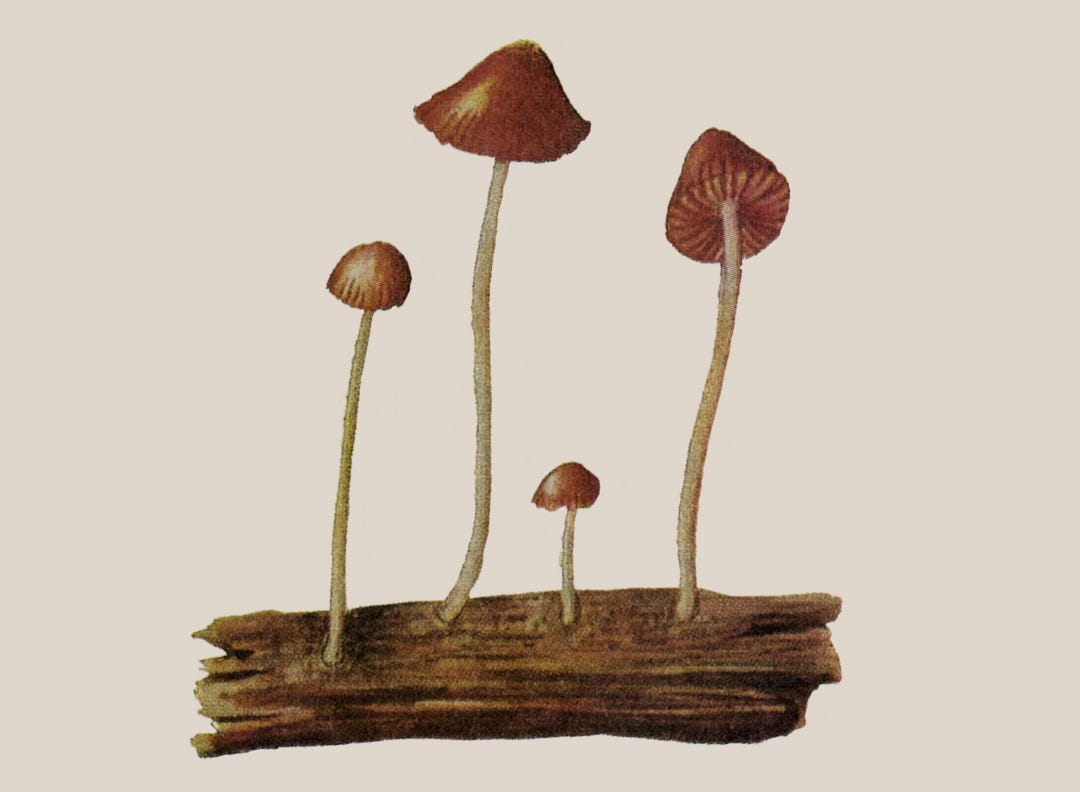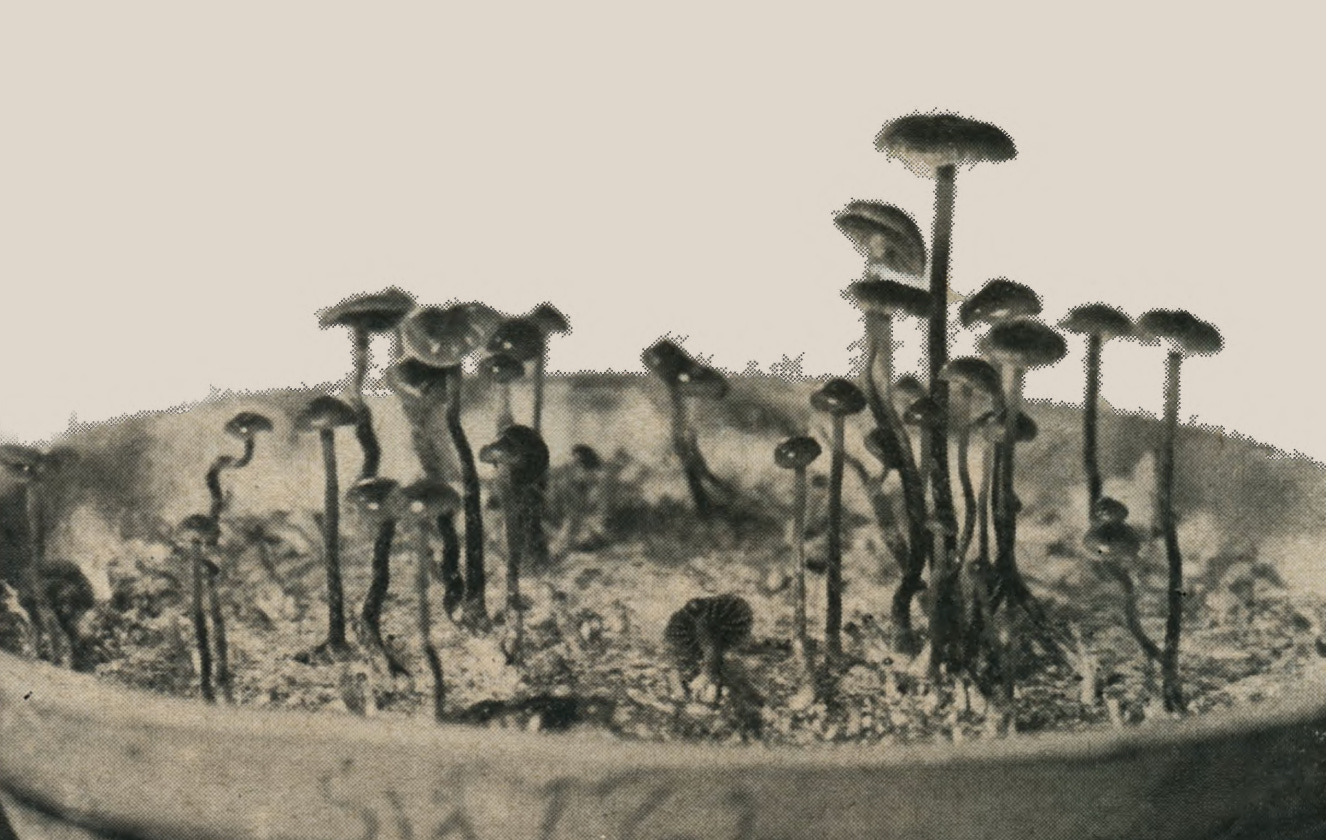History of Shrooms
A condensed excerpt from Lenny's research paper from law school, "Legal Frameworks for Psilocybin: A 'Magic' New Frontier for Mental Health Treatment."
Shrooms — despite demonstrating immense therapeutic potential for treating depression, anxiety, addictions, and more — are federally illegal in the U.S. Why?
Background
Psilocybin, the psychoactive compound in shrooms, occurs naturally in 100+ species of fungi worldwide. Different Psilocybe species have been discovered from Australia to England to U.S. Pacific Northwest (s/o Portland).
When ingested, psilocybin binds to receptors in the brain responsible for sensory input. When a sufficient quantity is consumed, thalamus activity decreases, leading to hallucinations. These effects generally take 20-40 mins to set in, and fade between 3-6 hrs — however, the experience is incredibly variable based on species of shroom, dosage, individual psychology, etc., underscoring the need for careful research.
5000 B.C. – 1950
Evidence across time and region suggest that humans have been consuming hallucinogenic mushrooms since pre-civilization: archeological clues suggest its use for deity worship in the Sahara desert 7000+ yrs ago and in Mesoamerica 5000+ yrs ago. Its use continued, often in religious contexts, into the modern era. In the 1400s, Spanish friars called shrooms the “flesh of the gods.” In the early 1900s, healers of the Mazatec people held mushroom vigils to heal the sick and offer advice.

Though not to be taken as scientific support for the use of psilocybin to treat mental illness, historical context gives insight into its spiritual and potential medicinal value.
1950s
In the U.S., shrooms came into popular culture via Gordon Wasson, a VP at J.P. Morgan, in the ‘50s.
Wasson, who was also an amateur mycologist, caught wind of the existence of mind-altering mushrooms in Mexico from a scholar friend. He traveled to Oaxaca to participate in local mushroom traditions. The experience was, as he described it, “soul shattering.” That year, he published an article in Life magazine titled “Seeking the Magic Mushroom: A New York Banker Goes to Mexico’s Mountains to Participate in the Age-Old Rituals of Indians Who Chew Strange Growths that Produce Visions.” (Looong ass title. By the way, all photos in this piece are reproduced from this article.)
Before his article, few people outside indigenous populations of Central America were aware of psilocybin. Soon after, “magic mushrooms” became a household name in the U.S.
The same year that Wasson first brought awareness of shrooms to the West, psilocybin was isolated and named by Swiss chemist Albert Hofmann, who famously synthesized LSD and discovered its hallucinogenic effects. The following year, Hofmann successfully synthesized psilocybin, which was sold by Sandoz Pharmaceuticals under the name Indocybin for pharmacological and therapeutic research.
At the time, the public was still on board with psychedelics research. Four short years later, legislation would prevent Sandoz from providing Indocybin to physicians, unless they worked within federal agencies or obtained permission from those agencies. What caused this abrupt shift in public opinion?
As it turns out, it may have started with two well-intentioned psychedelics enthusiasts at Harvard University.
1960s
In the early ‘60s, two Harvard psychology professors (Timothy Leary and Richard Alpert) began the Harvard Psilocybin Project, a series of experiments involving psilocybin and other psychedelics. They wanted to describe the subjective effects of shrooms in naturalistic studies. Leary and Alpert administered to human subjects.
There was a potential ethical concern, however: they were not medical doctors, and they conducted these experiments without medical supervision, which was possible due to lack of regulation. Although their subjects were consenting and informed adults, the Harvard Psilocybin Project was controversial, and backlash soon followed. In 1962, the Food, Drug, and Cosmetics Act was amended to require FDA permission before psychedelics could be administered in research studies.
The amendments spelled trouble for the Harvard Psilocybin Project. Not only was it now harder to obtain shrooms, Leary and Alpert drew increasing criticism from the Harvard community for their unwillingness to follow the new strict regulations.
That year, Leary and Alpert left Harvard to start the International Federation for Internal Freedom. Public perception of psychedelics went downhill from there. As Professor Marlan writes,
Leary’s subsequent zealous advocacy, multiple arrests and imprisonments, and increasingly bizarre conduct contributed greatly to the moral panic surrounded psychedelics in the mid-to-late 1960s.
Of course, Leary was not the only public advocate of psychedelics nor the sole reason that psychedelics fell from grace in the public eye. Michael Pollan writes that the psychedelic “upheaval would almost certainly have happened without Timothy Leary.”
In 1965, further amendments to the Food, Drug, and Cosmetics Act prohibited the sale, manufacture, and process of any hallucinogen, with limited exceptions. From there, the FDA began shutting down psychedelics research programs.
In 1968, possession of LSD was criminalized. Despite the positive findings of psychedelics research at the time, psychedelics rapidly lost favor in the public eye in the 1960s. Professor Marlan points to the “negative publicity from the Harvard Psilocybin Project and Leary’s later conduct” as reasons for the shift. Additionally, exaggerated media coverage of psychedelics grossly misrepresented the nature of the substances, reporting brain damage and drug-induced insanity.
Political motivation added fuel to the fire. American leaders blamed psychedelics as a catalyst for anti-Vietnam War sentiment and the rejection of social norms by the younger generation. Journalist Don Lattin writes,
Psilocybin mushrooms . . . gave us a new appreciation of our interconnectedness to the rest of the natural world, inspiring the environmental movement.
This sense of compassion did not help the military-industrial complex persuade us that it was a good idea to send hundreds of thousands of young men to the other side of the world to slaughter people.
Adhering the call to “Question Everything,” the younger generation had become increasingly critical of the reality of their society — this movement against mainstream culture became known as the counterculture.
The War on Drugs, driven by the Nixon Administration, is now recognized as a politically motivated power play to suppress the counterculture and to oppress racial minorities. Psychedelics in particular, including psilocybin, were associated with anti-war and environmentalist movements. President Richard Nixon’s top advisor, John Erlichman, later admitted to the War on Drug’s culturist and racist roots:
You want to know what this was really about? The Nixon campaign, and the Nixon White House after that, had two enemies: the antiwar Left and Black people.
We couldn’t make it illegal to be either against the war or Black, but by getting the public to associate the hippies with marijuana and blacks with heroin, and then criminalizing both heavily, we could disrupt those communities. We could arrest their leaders, raid their homes, break up their meetings, and vilify them night after night on the evening news.
Did we know we were lying about the drugs? Of course we did.
1970s – Present
In 1970, Nixon called Leary “the most dangerous man in America” for promoting psychedelics. That year, Congress nailed the coffin with the Controlled Substances Act (“CSA”). To this day, the CSA serves as the cornerstone for federal drug control.
The CSA regulates the manufacture, distribution, sale, possession, and research of substances under its control. It divides controlled substances into five categories, from Schedule I to Schedule V, representing the highest to lowest potential for abuse. Classic psychedelics, including psilocybin, were placed in Schedule I.
As if the federal barrier was not enough, psychedelics would soon face international scrutiny. The 1971 United Nations Convention on Psychotropic Drugs placed classic psychedelics under strict international control. Many nations signed onto the treaty, following the lead of the U.S.
This international moratorium on psychoactive substances, including shrooms, is still in effect today.








